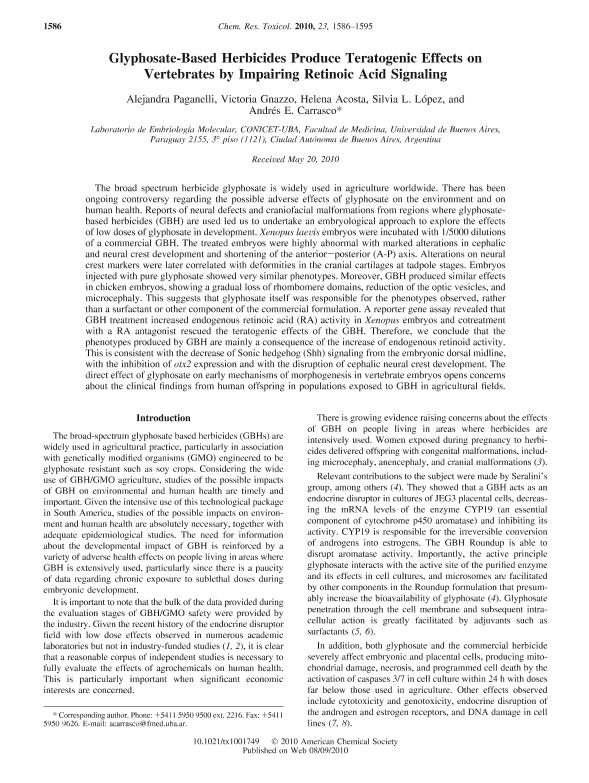Mostrar el registro sencillo del ítem
dc.contributor.author
Paganelli, Alejandra Raquel

dc.contributor.author
Gnazzo, Victoria

dc.contributor.author
Acosta, Helena
dc.contributor.author
Lopez, Silvia Liliana

dc.contributor.author
Carrasco, Andres Eduardo

dc.date.available
2019-01-08T20:04:05Z
dc.date.issued
2010-10
dc.identifier.citation
Paganelli, Alejandra Raquel; Gnazzo, Victoria; Acosta, Helena; Lopez, Silvia Liliana; Carrasco, Andres Eduardo; Glyphosate-based herbicides produce teratogenic effects on vertebrates by impairing retinoic acid signaling; American Chemical Society; Chemical Research In Toxicology (Washington); 23; 10; 10-2010; 1586-1595
dc.identifier.issn
0893-228X
dc.identifier.uri
http://hdl.handle.net/11336/67699
dc.description.abstract
The broad spectrum herbicide glyphosate is widely used in agriculture worldwide. There has been ongoing controversy regarding the possible adverse effects of glyphosate on the environment and on human health. Reports of neural defects and craniofacial malformations from regions where glyphosate-based herbicides (GBH) are used led us to undertake an embryological approach to explore the effects of low doses of glyphosate in development. Xenopus laevis embryos were incubated with 1/5000 dilutions of a commercial GBH. The treated embryos were highly abnormal with marked alterations in cephalic and neural crest development and shortening of the anterior posterior (A-P) axis. Alterations on neural crest markers were later correlated with deformities in the cranial cartilages at tadpole stages. Embryos injected with pure glyphosate showed very similar phenotypes. Moreover, GBH produced similar effects in chicken embryos, showing a gradual loss of rhombomere domains, reduction of the optic vesicles, and microcephaly. This suggests that glyphosate itself was responsible for the phenotypes observed, rather than a surfactant or other component of the commercial formulation. A reporter gene assay revealed that GBH treatment increased endogenous retinoic acid (RA) activity in Xenopus embryos and cotreatment with a RA antagonist rescued the teratogenic effects of the GBH. Therefore, we conclude that the phenotypes produced by GBH are mainly a consequence of the increase of endogenous retinoid activity. This is consistent with the decrease of Sonic hedgehog (Shh) signaling from the embryonic dorsal midline, with the inhibition of otx2 expression and with the disruption of cephalic neural crest development. The direct effect of glyphosate on early mechanisms of morphogenesis in vertebrate embryos opens concerns about the clinical findings from human offspring in populations exposed to GBH in agricultural fields.
dc.format
application/pdf
dc.language.iso
eng
dc.publisher
American Chemical Society

dc.rights
info:eu-repo/semantics/openAccess
dc.rights.uri
https://creativecommons.org/licenses/by-nc-sa/2.5/ar/
dc.subject
Xenopus
dc.subject
Ra
dc.subject
Shh
dc.subject
Neural Crest
dc.subject.classification
Otras Ciencias Biológicas

dc.subject.classification
Ciencias Biológicas

dc.subject.classification
CIENCIAS NATURALES Y EXACTAS

dc.title
Glyphosate-based herbicides produce teratogenic effects on vertebrates by impairing retinoic acid signaling
dc.type
info:eu-repo/semantics/article
dc.type
info:ar-repo/semantics/artículo
dc.type
info:eu-repo/semantics/publishedVersion
dc.date.updated
2019-01-07T13:34:46Z
dc.journal.volume
23
dc.journal.number
10
dc.journal.pagination
1586-1595
dc.journal.pais
Estados Unidos

dc.journal.ciudad
Washington
dc.description.fil
Fil: Paganelli, Alejandra Raquel. Universidad de Buenos Aires. Facultad de Medicina; Argentina. Consejo Nacional de Investigaciones Científicas y Técnicas; Argentina
dc.description.fil
Fil: Gnazzo, Victoria. Universidad de Buenos Aires. Facultad de Medicina; Argentina. Consejo Nacional de Investigaciones Científicas y Técnicas; Argentina
dc.description.fil
Fil: Acosta, Helena. Universidad de Buenos Aires. Facultad de Medicina; Argentina
dc.description.fil
Fil: Lopez, Silvia Liliana. Universidad de Buenos Aires. Facultad de Medicina; Argentina. Consejo Nacional de Investigaciones Científicas y Técnicas; Argentina
dc.description.fil
Fil: Carrasco, Andres Eduardo. Universidad de Buenos Aires. Facultad de Medicina; Argentina. Consejo Nacional de Investigaciones Científicas y Técnicas; Argentina
dc.journal.title
Chemical Research In Toxicology (Washington)

dc.relation.alternativeid
info:eu-repo/semantics/altIdentifier/doi/http://dx.doi.org/10.1021/tx1001749
dc.relation.alternativeid
info:eu-repo/semantics/altIdentifier/url/https://pubs.acs.org/doi/abs/10.1021/tx1001749
Archivos asociados
